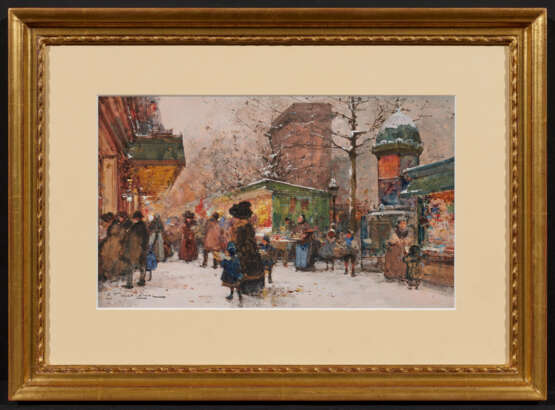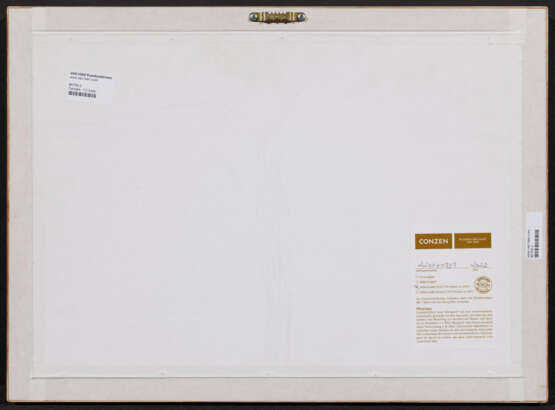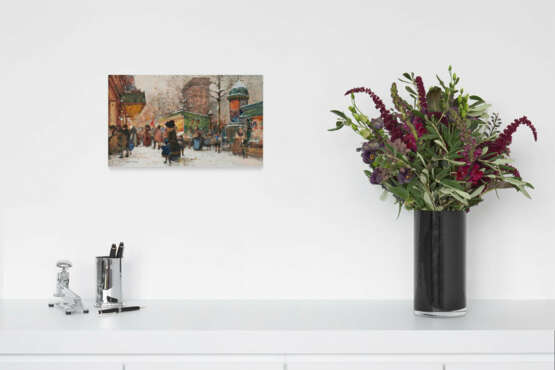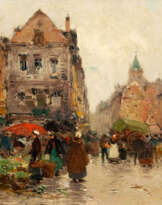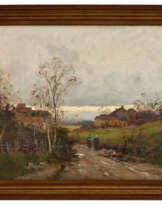ID 1424244
Lot 1367 | Paris. Winter Day at the Boulevard Saint Denis
Valeur estimée
€ 5 000 – 8 000
('A. Michel')1854 Paris - 1941 Chérence
Title: Paris. Winter Day at the Boulevard Saint Denis.
Technique: Watercolour and gouache on paper.
Mounting: Mounted.
Measurement: 20 x 32cm.
Notation: Signed lower left: "E. Galien-Laloue".
Frame: Framed.
Verso:
On the paper inscribed with pencil.
Provenance:
Private ownership, Germany.
The European grand boulevards and promenades as the Roman Corso, the Wien Ringstraße or the street Unter den Linden in Berlin were stages on which the aspring bourgeoisie could celebrate the "see and being seen" in the 19th century. The boulevards in Paris, which had been created at the northern side of the Seine instead of old city walls in the 18th century, were rolemodels for these spectacles of city design. Since the 19th century and until today the "Grands Boulevards" of Paris have been highly significant not only for transport but also socially. Having partly been designed as allies, the broad streets invite to a stroll. Historical buildings, luxurious shops and inviting cafés and restaurants seduce passerbys to rest. Not only the Parisian population but also the continuously growing number of tourists since the 19th century frequent the boulevards and is captured by the metropolitan charm of the French metropolis.
Two artist who have painted portraits of Paris over and over again are Eugène Galien-Laloue (1854-1941) and Émanuel Cortès (1882-1969) of whom we can present two views of the boulevards each here.
Eugene Galien-Laloue (cat. 1367 and cat. 1368) was born at the Montmartre. After his father's early death, a theatre painter, he worked as a notary writer at first, later as an engineering draftsman at the French National Railways Corporation. Simultaneously, he was creating views of different Parisian city quarters as well as landscapes of the Parisian outskirts. His works that are mostly carried out as gouache works convince the viewers with their exact perspectives and the excellently observed lighting conditions at different daytimes, the moods during different weather events and different seasons. Galien-Laloue's paintings grews equally popular with Parisian citizens and tourists. He worked together with different gallerists, however, he likewise sold his works in luxurious stores and adopts divers pseudonyms for these purposes. Bothe works presented here each show the lively boulevard St. Denis with a lateral view of the triumphal arch Porte St. Denis with only slightly varying point of views. The lighting conditions indicate an autumnal or wintery afternoon. The aritifcial lighting partly has already been switched on with fading daylight and provides the boulevard with a special glamour.
Édouard Cortès was 28 years younger than Galien-Lalou. He was born in the Paris region into a family of Spanish painters. Cortès went to Paris to study in 1899 and learnt painting at the École des Beaux-Arts under Antoine Bouguereau, the old master of Salon painters. As early as 1901, the young painter was able to attract attention at the Salon des Indépendants. Cortès specialised in views of Paris in a late Impressionist style. The setting of his paintings does not always provide a clue as to their date. Édouard Cortès was conservative in the true sense of the word. He wanted to preserve the "Belle Epoque" and also enlivened his later street scenes with older carriages and fashion styles from before the Second World War.
The two paintings presented here show the Boulevard St. Denis (cat. 1370) and the Boulevard de la Madelaine (cat. 1369), supposedly in the 1930s. It is autumn and the streets are glistening with rain. Édouard Cortès was also interested in depicting the 'blue hour', the time when the daylight is still just there, but when the artificial lighting already effectively illuminates the scenery.
| Artiste: | Eugène Galien-Laloue (1854 - 1941) |
|---|---|
| Catégorie maison de vente aux enchères: | Aquarelles, Dessins et Pastels |
| Artiste: | Eugène Galien-Laloue (1854 - 1941) |
|---|---|
| Catégorie maison de vente aux enchères: | Aquarelles, Dessins et Pastels |
| Adresse de l'enchère |
VAN HAM Kunstauktionen GmbH Hitzelerstr. 2 50968 Köln Allemagne | ||||||||||||||
|---|---|---|---|---|---|---|---|---|---|---|---|---|---|---|---|
| Aperçu | |||||||||||||||
| Téléphone | +49 221 92586215 | ||||||||||||||
| Fax | +49 221 92 58 62 4 | ||||||||||||||
| Commission | 32% | ||||||||||||||
| Conditions d'utilisation | Conditions d'utilisation | ||||||||||||||
| Heures d'ouverture | Heures d'ouverture
|

